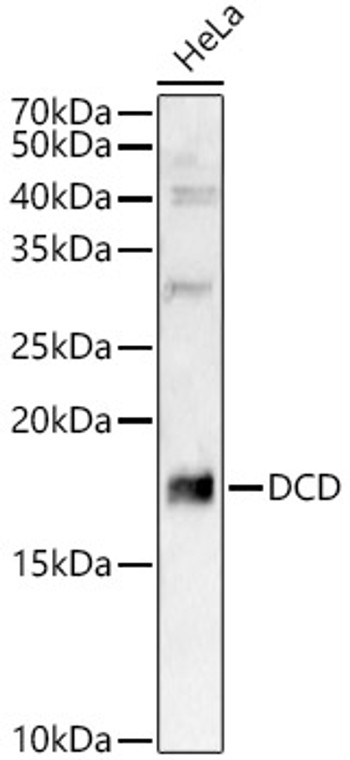| Host: |
Rabbit |
| Applications: |
WB/ELISA |
| Reactivity: |
Human/Mouse |
| Note: |
STRICTLY FOR FURTHER SCIENTIFIC RESEARCH USE ONLY (RUO). MUST NOT TO BE USED IN DIAGNOSTIC OR THERAPEUTIC APPLICATIONS. |
| Clonality: |
Polyclonal |
| Conjugation: |
Unconjugated |
| Isotype: |
IgG |
| Formulation: |
PBS with 0.02% Sodium Azide, 50% Glycerol, pH 7.3. |
| Purification: |
Affinity purification |
| Concentration: |
Lot specific |
| Dilution Range: |
WB:1:2000-1:9000ELISA:Recommended starting concentration is 1 Mu g/mL. Please optimize the concentration based on your specific assay requirements. |
| Storage Instruction: |
Store at-20°C for up to 1 year from the date of receipt, and avoid repeat freeze-thaw cycles. |
| Gene Symbol: |
DCD |
| Gene ID: |
117159 |
| Uniprot ID: |
DCD_HUMAN |
| Immunogen Region: |
20-110 |
| Specificity: |
Recombinant fusion protein containing a sequence corresponding to amino acids 20-110 of human DCD (NP_444513.1). |
| Immunogen Sequence: |
YDPEAASAPGSGNPCHEASA AQKENAGEDPGLARQAPKPR KQRSSLLEKGLDGAKKAVGG LGKLGKDAVEDLESVGKGAV HDVKDVLDSVL |
| Tissue Specificity | Detected in urine (at protein level). Constitutively expressed in eccrine sweat gland cells (at protein level). Secreted into the sweat at a concentration of 1-10 micrograms/ml. |
| Function | DCD-1: Found in sweat, has an antimicrobial activity during early bacterial colonization. The secreted peptide assembles into homohexameric complexes that can associate with and also insert into pathogen membranes. Once inserted in bacteria membranes forms anion channels probably altering the transmembrane potential essential for bacterial survival. Highly effective against E.coli, E.faecalis, S.aureus and C.albicans. Optimal pH and salt concentration resemble the conditions in sweat. Also exhibits proteolytic activity, cleaving on the C-terminal side of Arg and, to a lesser extent, Lys residues. Survival-promoting peptide: Promotes survival of neurons and displays phosphatase activity. It may bind IgG. |
| Protein Name | DermcidinPreproteolysin Cleaved Into - Survival-Promoting Peptide - Dcd-1 |
| Database Links | Reactome: R-HSA-6803157 |
| Cellular Localisation | SecretedSurvival-Promoting Peptide: SecretedDcd-1: SecretedMembranePeripheral Membrane ProteinSingle-Pass Membrane ProteinThe Secreted Peptide Assembles Into Homohexameric Complexes That Can Probably Associate With Pathogen Membranes And Also Insert Into These Membranes Where They Behave As Channels |
| Alternative Antibody Names | Anti-Dermcidin antibodyAnti-Preproteolysin Cleaved Into - Survival-Promoting Peptide - Dcd-1 antibodyAnti-DCD antibodyAnti-AIDD antibodyAnti-DSEP antibody |
Information sourced from Uniprot.org
12 months for antibodies. 6 months for ELISA Kits. Please see website T&Cs for further guidance








